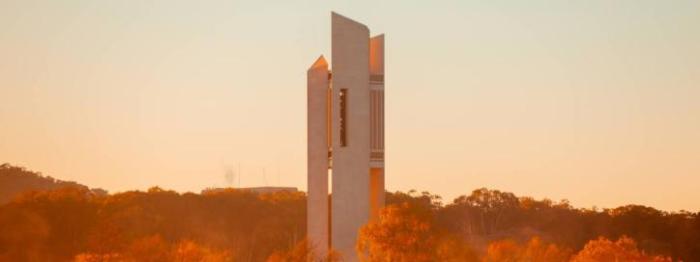National Carillon |

Located on Queen Elizabeth II Island, Lake Burley Griffin, the National Carillon was a gifted to the City of Canberra in commemoration of the Golden Jubilee of the founding of the National Capital of Australia from the British Government.
With 57 bronze bells, the National Carillon is large by world standards. The pitch of the bells ranges chromatically through four- and one-half octaves. The bells each weigh between seven kilograms and six tonnes. Cast in England by John Taylor & Co of Loughborough, they are fine examples of the art of bellfounding.
With the tower rising to a height of 50 metres, the music of the bells drifts across Lake Burley Griffin and through Kings and Commonwealth Parks. The tower is lit at night, providing a magnificent landmark in the National Capital.
Carillonists play the suspended stationary bells from a keyboard of wooden batons and pedals, called a clavier. A system of individual cables and wire linkages draws soft iron clappers on to the bells as each wooden baton or pedal is struck by the carillonist. A separate automated mechanical system of operation allows the quarter hour striking of the Westminster chimes.
Much variation of musical expression is obtainable in the hands of a competent carillonist. Carillon 'schools' are well established in Europe and North America and Australian carillonists regularly participate in international recitals. The National Carillon can also be played in concert with other instruments.
Local and visiting carillonists perform recitals at the National Carillon throughout the year. All styles of music are represented, from compositions especially written for the carillon to popular song arrangements and improvisation. It is often used to celebrate special occasions and in conjunction with other events.
The National Carillon is managed and maintained by the National Capital Authority on behalf of the Commonwealth of Australia.
History
The National Carillon tower was the prize-winning design of Western Australian architects Cameron, Chisholm & Nicol. The design of the tower comprises three angular columns clad in quartz and opal chip. Each shaft is a triangle in plan, and each is aligned with one of the three sides of a central equilateral triangle. Each of the shafts serves a different function: the highest contains a passenger lift, the next a steel staircase, and the lowest is a service shaft. The maximum height of the tower is 50 metres from ground level. The first floor is approximately halfway up the tower and contains the chamber for the clavier that operates the bells, space for other musicians to play in concert with the carillon, and facilities for the carillonist. Above this is the bell chamber itself, and lastly, at a height of 36 metres above ground level, is a small viewing called 'Chimes'.
The Carillon was constructed with a concrete frame and site-fabricated, by positioning and jointing the cladding, erecting self-climbing formwork on the inside and infilling stage by stage from the bottom with reinforcement and concrete. An aperture had to be left in the centre of the floor to allow the biggest bells to be hoisted to the bell chamber, since they were too large to pass up any of the three shafts.
Queen Elizabeth II officially opened the National Carillon on 26 April 1970. John Douglas Gordon, after whom the Queen Elizabeth II Island footbridge is now named, played the inaugural recital.
Missing the music?
The National Carillon (the Carillon) is undergoing instrumental improvements and repairs.
After 50 years of service, the internal instrumental components are being refreshed and upgraded. While the works are being undertaken, recitals have been suspended, however you may hear our National Carillonists practising from time to time.
While you are waiting for the concerts to return - pop into the National Capital Exhibition at Regatta Point see the original instrument that was installed in 1969 and learn more about the story of the whole National Capital.
The National Capital Exhibition is open weekdays 9am to 5pm and weekends 10am to 4 pm.
National Carillon Recital Times
Closed for renovations
Information and bookings
phone (02) 6272 2902
email nce@nca.gov.au
Access to the National Carillon is via Kings Avenue (north bound lane only).
❊ Address ❊
⊜ Queen Elizabeth II Island, Lake Burley Griffin View Map
❊ More Information ❊
→
www.chiquel.com.au
Update Page







